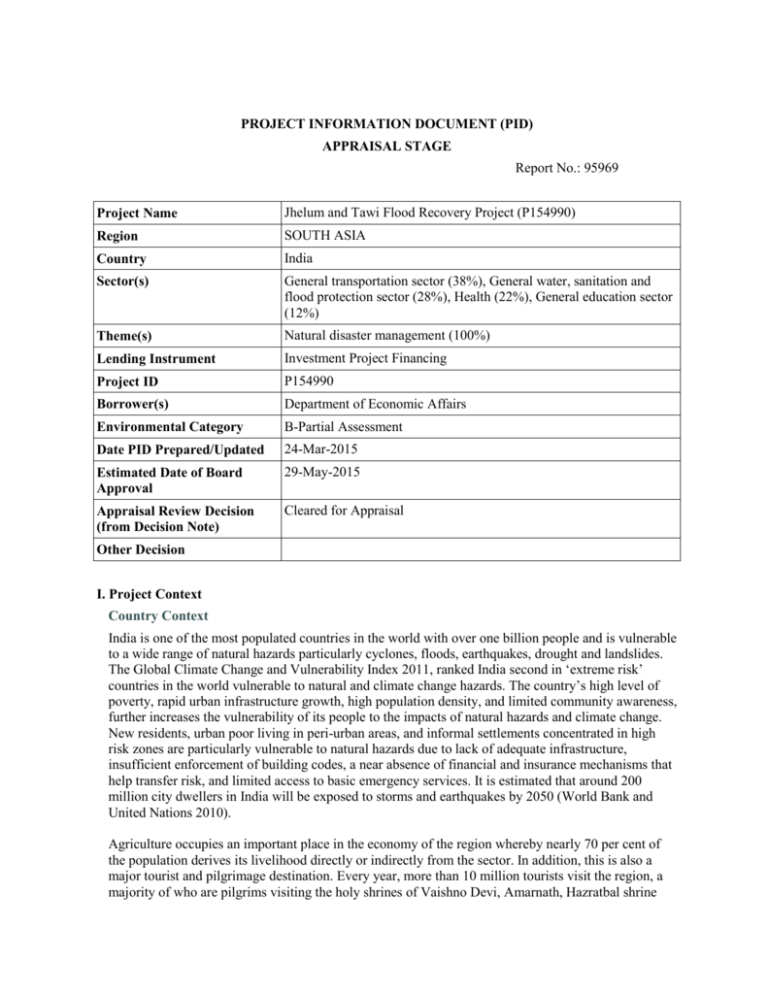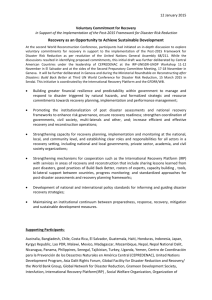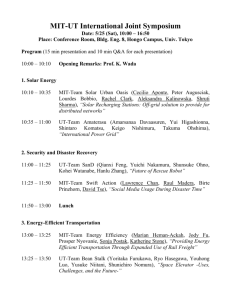PROJECT INFORMATION DOCUMENT (PID) APPRAISAL STAGE
advertisement

. PROJECT INFORMATION DOCUMENT (PID) APPRAISAL STAGE Report No.: 95969 . Project Name Jhelum and Tawi Flood Recovery Project (P154990) Region SOUTH ASIA Country India Sector(s) General transportation sector (38%), General water, sanitation and flood protection sector (28%), Health (22%), General education sector (12%) Theme(s) Natural disaster management (100%) Lending Instrument Investment Project Financing Project ID P154990 Borrower(s) Department of Economic Affairs Environmental Category B-Partial Assessment Date PID Prepared/Updated 24-Mar-2015 Estimated Date of Board Approval 29-May-2015 Appraisal Review Decision (from Decision Note) Cleared for Appraisal Other Decision . I. Project Context Country Context India is one of the most populated countries in the world with over one billion people and is vulnerable to a wide range of natural hazards particularly cyclones, floods, earthquakes, drought and landslides. The Global Climate Change and Vulnerability Index 2011, ranked India second in ‘extreme risk’ countries in the world vulnerable to natural and climate change hazards. The country’s high level of poverty, rapid urban infrastructure growth, high population density, and limited community awareness, further increases the vulnerability of its people to the impacts of natural hazards and climate change. New residents, urban poor living in peri-urban areas, and informal settlements concentrated in high risk zones are particularly vulnerable to natural hazards due to lack of adequate infrastructure, insufficient enforcement of building codes, a near absence of financial and insurance mechanisms that help transfer risk, and limited access to basic emergency services. It is estimated that around 200 million city dwellers in India will be exposed to storms and earthquakes by 2050 (World Bank and United Nations 2010). Agriculture occupies an important place in the economy of the region whereby nearly 70 per cent of the population derives its livelihood directly or indirectly from the sector. In addition, this is also a major tourist and pilgrimage destination. Every year, more than 10 million tourists visit the region, a majority of who are pilgrims visiting the holy shrines of Vaishno Devi, Amarnath, Hazratbal shrine and the Buddhist monasteries of Ladakh which contribute significantly to the overall economy. The region, owing to its geographical and geo-climatic setting, is a multi-hazard prone region that has experienced natural disasters like earthquakes, floods, landslides, avalanches, high velocity winds, and snowstorms. Most parts of the Srinagar Valley and northern districts fall in Seismic Zone V. The rest of the southern districts fall in the Seismic Zone IV. Floods and flash floods are also frequent. Floods generally occur in the summer when heavy rains are followed by snowmelt. The continuous spell of rains from September 2-6, 2014, caused Jhelum, Chenab and Tawi rivers as well as many other streams/tributaries to flow above the danger mark. Due to the unprecedented heavy during rainfall, the catchment areas, particularly the low lying areas were flooded for more than two weeks. The Jhelum River breached its banks flooding many low-lying areas around it. Some areas in Srinagar city remained flooded for upto 28 days, with water levels rising as high as 27 feet in several parts of the city. Water levels also increased in Chenab and Tawi Rivers, both of which were flowing above normal levels. As a result of the total flooding, nearly 1.5 million families were affected, directly or indirectly, and some 300 lives lost. More than 648,000 hectares of agricultural and horticultural land were affected causing huge loss to crops. The region affected by these floods will be the focus of the proposed project, consists of 22 districts. According to Census of India 2011, the region has a population of 12.5 million, registering a population density of 56 persons per sq.km and a sex ratio of 883 females per 1,000 men. The literacy level is 67.16 per cent with men having a literacy rate of 76.75 per cent, while female literacy is 49.12 per cent. Sectoral and institutional Context India’s commitment to disaster preparedness and risk reduction at the national and state levels prompted the enactment of the Disaster Management Act in 2005, establishing the NDMA and State Disaster Management Authorities (SDMAs). NDMA has proactively formulated guidelines and procedures for dealing with specific natural disasters and is mandated with framing policies, plans and guidelines for Disaster Management. As per the provisions of National Disaster Management Act, 2005, the affected State has constituted the State Disaster Management Authority (SDMA) and the State Executive Committee (SEC). However, in the present form, the SDMA is only a de-facto committee and is not an autonomous institution involved in the day-to-day work connected with policy, planning, implementation, coordination, and quality control of disaster risk management activities. A state disaster management policy was also developed in 2011 that aimed at mainstreaming disaster risk reduction into all the developmental initiatives to ensure sustainability of investments and minimizing the losses due to disasters. The World Bank has significantly increased its support to India in advancing its Disaster Risk Management (DRM) capacity. The Bank is financing five projects under implementation: the National Cyclone Risk Mitigation Project I, Tamil Nadu and Puducherry Coastal Disaster Risk Reduction Project, Bihar Kosi Disaster recovery Project, Uttarakhand Disaster Recovery Project, and the Odisha Disaster Recovery Project. In addition to reconstruction and adaptation infrastructure, all of these projects finance activities to improve DRM capacity at the state and national levels, including analytical work, equipment, training, and in particular the establishment of systems for better risk management such as improved forecasting, early warning systems, community based DRM, multihazard risk assessments for planning, and decision support systems. . II. Project Development Objective(s) The project development objective is to support the recovery and increase disaster resilience in targeted areas of the Project Implementing Entity, and increase the capacity of the Project Implementing Entity to respond promptly and effectively to an eligible crisis or emergency. . III. Project Description Component Name Reconstruction and strengthening of critical infrastructure Comments (optional) The objective of this component is to support the reconstruction/restoration of damaged public buildings, such as hospitals, schools, higher education buildings, fire stations, and selected block and district offices, and other important public buildings. It will include the restoration of partially damaged structures and the reconstruction of fully damaged structures, including equipment and furniture. Component Name Reconstruction of roads and bridges Comments (optional) The objective of this component is to restore and improve the connectivity disrupted due to the disaster through the reconstruction of damaged roads and bridges. The infrastructure will be designed to withstand earthquake and flood forces as per the latest official design guidelines. The affected areas will benefit by the restored access to the markets thereby increasing the economic growth in these areas and timely access to health and education services. Restoration of roads will also serve as supply/rescue lines in the event of disaster. Component Name Restoration of urban flood management infrastructure Comments (optional) The objective of this component is to strengthen and reinforce existing weak and vulnerable flood control infrastructure. Investments will primarily include rehabilitation/renovation of storm water pumping stations in Srinagar city, and replacement of the power equipment, switch/ panel boards at elevated places, and related investments for improvement and increased resilience. Component Name Restoration and strengthening of livelihoods Comments (optional) The objective of this component is to support the recovery of affected non-farm livelihoods through restoration of physical and productive assets and technical assistance to increase livelihoods resilience. Component Name Strengthening disaster risk management capacity Comments (optional) The objective of this component is to enhance the capabilities of government entities in managing disaster risks, enhancing preparedness, and achieving resilient recovery. This component will entail the following: Sub-component 5.1: Capacity building for disaster management; and Sub-component 5.2: Technical assistance for risk reduction and response preparedness. Component Name Contingent Emergency Response Comments (optional) Following an adverse natural event that causes a major natural disaster, the government may request the Bank to re-allocate project funds to support response and reconstruction. This component would draw resources from the unallocated expenditure category and/or allow the government to request the Bank to re-categorize and reallocate financing from other project components to partially cover emergency response and recovery costs. This component could also be used to channel additional funds should they become available as a result of the emergency. Component Name Implementation Support Comments (optional) This component would finance incremental operating costs of the Project, including the operation of the Project Management Unit (PMU) and Project Implementation Units (PIUs). In addition, the component will include consultancies required for the preparation and supervision of specific activities, trainings, exposure visits and knowledge exchange programs, etc. . IV. Financing (in USD Million) Total Project Cost: 250.00 Financing Gap: 0.00 Financing Source BORROWER/RECIPIENT Total Bank Financing: 250.00 Amount 0.00 International Development Association (IDA) 250.00 Total 250.00 . V. Implementation A Project Steering Committee (SC) will be set up for the overall strategy guidance and monitoring of the project. It will be headed by the Chief Secretary and will comprise all involved line departments, and additionally the departments of Finance, Planning, Environment, and Social Welfare. The SC will formally approve the project investments and help coordinate the activities of various departments, including in obtaining required approvals/clearances for the Project. A Project Management Unit (PMU), housed within the Relief & Rehabilitation Department, will be responsible for overall project management, coordination, and reporting, and for implementation of Component 5. The PMU will also be responsible to carry out procurement of goods, services, and small scale works for other components, with technical inputs from the relevant line departments. There will be three Project Implementation Units (PIUs) that will be set up at the beginning of the Project. During project implementation, additional PIUs might be set-up depending on the volume of investments and capacity. The three PIUs are: (i) Roads and Building Department (R&B), will be responsible for all civil works under Components 1, and 2, and it will receive technical inputs from the Departments of Health, Higher Education, Fire, and others as relevant depending on the civil works; (ii) Srinagar Municipal Corporation (SMC) will be responsible for implementation of Component 3 and it will be assisted by the Urban Environment Engineering Department (UEED) for technical inputs and procurement of goods, works, and services in line with its official responsibilities and capacity; and (iii) Industry & Commerce Department (I&CD) and will be responsible for implementation of Component 4 with support from other agencies. VI. Safeguard Policies (including public consultation) Safeguard Policies Triggered by the Project Environmental Assessment OP/BP 4.01 Yes No X Natural Habitats OP/BP 4.04 X Forests OP/BP 4.36 X Pest Management OP 4.09 X Physical Cultural Resources OP/BP 4.11 X Indigenous Peoples OP/BP 4.10 X Involuntary Resettlement OP/BP 4.12 X Safety of Dams OP/BP 4.37 X Projects on International Waterways OP/BP 7.50 X Comments (optional) The project will target areas that were hit hardest by the devastating floods in the region. Given the magnitude of damage caused by flooding and associated landslides, the project is designed to provide reconstruction and recovery support to affected areas in which public infrastructure and service delivery were impacted severely. It is expected that it will yield benefits and livelihood opportunities through provision of high priority reconstruction and rehabilitation of public infrastructure in the worst affected areas of the region in addition to enhancing government’s capacity in dealing with future disasters. Based on rapid/current assessment, the Project is classified as category “B”. A comprehensive Environment and Social Safeguard Management Framework (ESMF) has been prepared that outlines that sub-projects will be selected after detailed/appropriate level of assessment, including consultation with concerned key stakeholders. An Environment and Social Screening Exercise will be carried out to ascertain need for additional environment and social assessments and completing consequent actions before taking up any subcomponent. VII. Contact point World Bank . Contact: Saurabh Suresh Dani Title: Senior Disaster Risk Management Specialist Tel: 473-8649 Email: sdani@worldbank.org Borrower/Client/Recipient Name: Department of Economic Affairs Contact: Ms. Aparna Bhatia Title: Director (MI) Tel: 91-11-23094452 Email: aparnabhatia2002@gmail.com . Implementing Agencies Name: Project Implementing Entity Contact: Mr. Bharat Bhushan Vyas Title: Principal Secretary Tel: 91-191-2546715 Email: bharatbhushanvyasias@gmail.com . VIII. For more information contact: The InfoShop The World Bank 1818 H Street, NW Washington, D.C. 20433 Telephone: (202) 458-4500 Fax: (202) 522-1500 Web: http://www.worldbank.org/infoshop






